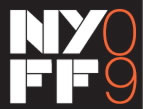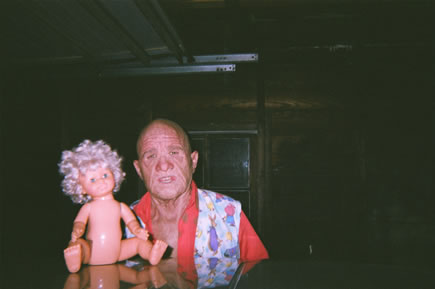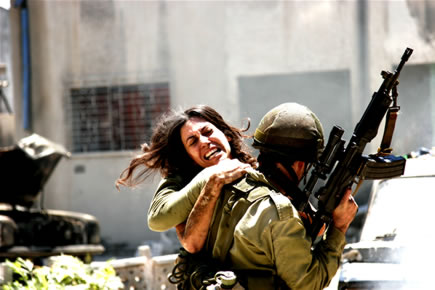The 2009 New York Film Festival
Written by: FFT Webmaster | October 15th, 2009

Presenting 28 feature and documentary productions the 47th edition of the New York Film Festival running from September 25 through October 11, certainly retained its standing as the premier US showcase for the international films and for presenting the best emerging and recognized international film directors.
Culled this year mostly from other festivals the NYFF had few films from the United States (THE ART OF THE STEAL, Don Argott; SWEETGRASS, Ilisa Barbash and Lucien Castaign-Taylor; LIFE DURING WARTIME, Todd Solondz; PRECIOUS, Lee Daniels) and even fewer New York premieres (KANIKOSEN, Sabu; GHOST TOWN, Zhao Dayong). But the program as assembled by Richard Pena , the festival director, Melissa Anderson, Scott Foundas, Jim Hoberman, and Dennis Lim is certainly among the best I have reviewed since attending the fest for the first time ten years ago. It is also remarkable how much several film makers from this year’s selection are in tune with the socio-psychological dynamics of our post-industrial society. This year the festival also had a retrospective of Chinese Cinema, a tribute to the Hindi director Guru Dutt, the views from the avant garde section including Pasolini’s remarkable RAGE and Serge Bromberg’s intriguing case study of Clouzot’s production of INFERNO. Certainly, as in prior years the function of the New York Film Festival is misunderstood thus the criticism of elitism by some writers looking for market oriented productions with upbeat themes and linear stories. But more than ever before the underlying orientation of grimness, depression, and suffering is singled out as best encapsulated by the New York Times, A.O. Scott headlining his festival review “Wallowing in Misery for Art’s Sake”. To suggest that directors like Lars von Trier, Michael Haneke, Samuel Maoz and others featured this year embrace misery for art’s sake is a gross simplification as is the notion that the demise of U.S. independent cinema accounts for the absence of more appealing titles at the festival. Film makers cannot be disconnected from the social context of the society they are living in and their films reflect the problems as they perceive them rather than an obsession with misery.
Post industrial societies, and specifically the United States are characterized by a loss of meaning, the difficulty of acquiring a reasonable identity, an increase in impulsive behavior, declining social integration, the unpredictability of structures surrounding us, rapid change in personal relations, turnover of values, and withdrawal into the private sphere. Individuals living in this society have a difficult time understanding what is happening them, can hardly shape their socio-economic environment since their lives are determined by institutions and processes totally out of their control. We better get used to the fact that reality can no longer be taken for granted and that, as social scientist have long suggested, nothing is obvious, and chance or random factors play a greater role.

Alain Resnais’ WILD GRASS, a marvelously photographed feature with stage actors delivering superb performances has also an underlying post modern theme. The characters cannot anticipate responses or motivations by others, nor reasons for actions. Thus they seem to miscommunicate frequently and the audience cannot make sense out of the non-linear behavior and is confronted with the bizarre moments pervading the film. At the end of the film the protagonist is apparently crashing a small air plane since he is obsessed closing his pants’ stuck zipper. Chaotic personal interactions between the principals and their apparent precarious identities stand in sharp contrast to cinematographic representation.
In VINCERE by Marco Bellocchio presents masterly presents the bleak passage of the secrete wife of Mussolini from ardent lover to her death in an insane asylum after the duce denies her and their son’s existence. The film signals the destruction by powerful state institutions of the individual and the truth they defend.

That there is only absurdity is clear in Harmony Korine’s TRASH HUMPERS where a couple of mostly drunk and psychotic seniors fornicate with garbage cans and trees, enjoy smashing television sets and neon tubes, and engage in other deranged escapades with dolls and everyday objects. The film is ‘experimental’, thus shot with hand held low fi video cameras, intentionally including all defects, poor sound, tracking problems, poor image etc. The viewers need not ask about the meaning of the lunatic romps nor relate to it as a ‘movie’, as they are cautioned by Korine. I prefer JULIEN DONKEY BOY to the humping of trash. It featured Werner Herzog who once considered Korine as “the future of American cinema”.

WHITE RIBBON ranks very high for me and is one of the best films in this year’s selection. Michael Haneke’s black and white portrayal of bizarre incidents in a small German protestant village during the year preceding the First World War is a powerful demonstration of what story telling is all about. Again for many reviewers this film is full of despair and depression, morbidity, presaging in its depiction of the social village landscape the horrors that would come. This is certainly one interpretation but as Haneke makes clear he does not want “manipulate the viewer as traditional film making does”, in upbeat, linear, closed stories on color film, “what mainstream cinema is good at”. Rather there is much ambiguity in the film, the narrator makes it clear that his memory may be defective, the audience is left with the task to figure out who committed the mutilation of two children, caused the accident of the village doctor, burned down a barn, etc. In other words we must complete the story in our minds and are thus forced to reflect. We are confronted by a rigid authoritarian village pastor and a village doctor with sadistic tendencies who possibly engages in incest. Parents lord over their children with undisputed authority and cruelty, and the children respond with submissive hatred, including an attempt to kill an infant, as revealed in a dream. The message Haneke seems to convey is that hidden behind the surface of civility there is our capacity for evil, brutality and malice and that this capacity is fostered by the pathological petty bourgeois authoritarian family structures he depicts. At that period of time Germany may have been the best example for extremism (and Adorno’s authoritarian personalities) but for Haneke the film cannot be reduced to it, rather it has a universal message. Yet as Haneke suggested in Cannes where his film received top honors…”If I tell a somber story there are always passages that show that the world could be different…to do justice to reality which is not just somber” as suggested by Haneke’s portrait of the village teacher and conversely the image of the village pastor “..If religion becomes absolute it becomes inhuman and perverted”. WHITE RIBBON strikes as me as authentic since of the story telling uses the language of the period (though much of it gets lost in the subtitles, ideally the audience should learn German first). Contributing is also Haneke’s use of few professional actors, his fast shooting and reliance on few rehearsals “…since they diminish spontaneity”. Given staging and framing of the film we seem to be party to a cinematic piece of theatre where the story is moved forward by the narration rather than the action. In short, the film is a superb demonstration of reflexive film making.
Haneke’s film was one of the most popular films at the festival with its screening totally sold out. It is of note that Lars von Trier’s much berated and controversial ANTICHRIST is also turning into a must see film. Though simplified, the film it can be best tagged as a primal Ingmar Bergman. Many reviewers had contradictory views of the film. Most agree on the extraordinary performances by the actors, specifically Charlotte Gainsbough but also Willem Dafoe, the merit of the convincing psychodrama shown by the film, the brilliant opening prologue, the superb cinematography, Trier’s outstanding creativity, his status as a master image maker etc, yet they fall short of giving von Trier the full credit he deserves for this film. Like Haneke Trier refuses to give clear cut responses and answers in this film and belittles, as any artist would do, attempts to impose structured meaning on his work. In ANTICHRIST we observe a couple who lost their only child in an accident while having sex. They leave for their isolated country side home ‘Eden’ deep in the forest where the husband, a psychotherapist, wants to cure his wife, a writer, of her deep depression after having convinced her to stop taking medication. Their relation is progressively deteriorating though interspersed with passionate but mechanical sex and moments of apparent normalcy. As in Sartre’s play Huis Clos both are cut off from ‘reality’, cannot exit from each other and confront each other in progressively violent encounters. The ‘therapy’ does not work and the wife who had been working there on a book about violence committed against woman and witch craft moves closer into madness with her husband in utter helplessness acting out so he maintains the evil she has been researching. After castrating him she performs a clitorectomy and attaches a stone weight to his leg so he cannot leave her. He escapes, kills and burns her and leaves Eden. Trier admits being influenced by David Lynch, the psychology of Japanese horror features and US films like THE SHINING and ROSEMARY’S BABY and also states not being excited about ANTICHRIST. But he refuses to be tied down to any specific interpretation thus rejects meaning and symbols attached by critics to ANTICHRIST whether they are Freudian or religious. Critics in turn apparently do not take Trier’s own statements seriously such as “I do not want to be very clear…nor emphasize symbolism”, “The film was done for its own sake and is not [intended as] a reflection of society” “The Idea was to make a horror film” and while brushing of the suggestion that he hates women since he ties evil to women he notes that “Women are as bad as men”. ANTICHRIST is a gripping film that has nothing to do with entertainment, a demonstration of superb image and story making, thus giving much space for reasoning by the viewer.

Over the last years the best Israeli films focused on the Arab Israeli conflict acted out in Lebanon as seen from the perspective of the soldiers with strong biographical overtones. Thus we had the award winning BEAUFORT and last year WALTZ WITH BASHIR. Now we are confronted with LEBANON from Samuel Maoz which secured the Golden Lion for best picture in Venice. Set completely inside a tank on a search mission with a platoon of paratroopers in a hostile town, LEBANON condenses the response of four soldiers to the claustrophobic setting and the fear of death. They think that their mission is failing mission while immured in the tank. Most contact to the outside is established through the images from the gunner’s scope, interrupted only briefly when the paratrooper officer descends on them to give orders. Use of the periscope reinforces the soldiers’ isolation and force the film audience to concentrate on the images of war and killing. On the outside the tank soldiers are under siege by a frequently invisible enemy. On the inside of the tank, the darkness, horror of the dirty cramped and bloody space, ignorance about their situation, failure of command, and poorly functioning equipment, makes a mockery of glorious war waging. Rather these scared tank soldiers who hardly left boyhood come across as anti-heroes who are motivated by the desire for survival and going home rather than the quest for medals.
The 2009 New York Film Festival delivered what it stands for, great stimulating films prompting to reflect rather than to entertain, defined by their artistic merit rather than potential box office success or emotional audience appeal.
Claus Mueller
New York Correspondent
filmexchange@gmail.com


